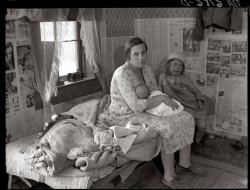
MAY CONTAIN NUTS

Search Shorpy
SHORPY ART

Framed or unframed, desk size to sofa size, printed by us in Arizona and Alabama since 2007. Explore now.
Join and Share
Ad-Free Shorpy
Shorpy is funded by you. Patreon contributors get an ad-free experience.
Learn more.

Recent comments
- Texas Flyer wanted
- Just a Year Too Soon
- WWII -- Replacing men with women at the railroad crossing.
- Yes, Icing
- You kids drive me nuts!
- NOT An Easy Job
- I wonder
- Just add window boxes
- Icing Platform?
- Indiana Harbor Belt abides
- Freezing haze
- Corrections (for those who care)
- C&NW at Nelson
- Fallen Flags
- A dangerous job made worse
- Water Stop
- Passenger trains have right of way over freights?
- Coal
- Never ceases to amaze me.
- Still chuggin' (in model form)
- Great shot
- Westerly Breeze
- For the men, a trapeze
- Tickled
- Sense of loneliness ...
- 2 cents
- Charm City
- What an Outrage
- Brighton Park
- Catenary Supports
Member Photos
The Shorpy
Print Emporium
Print Emporium
Search Shorpy
Search results -- 30 results per page
- Foot Traffic: 1941
- ... last seen here . Acetate negative by John Vachon for the Farm Security Administration. View full size.
I'm waiting for a ... Posted by Dave - 01/10/2020 - 5:04pm -
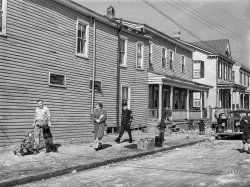
- Ask at Bar: 1941
- ... must be mistaken! Photo by Marion Post Wolcott for the Farm Security Administration. View full size.
A respectable joint No ... Posted by Dave - 01/09/2018 - 8:41pm -
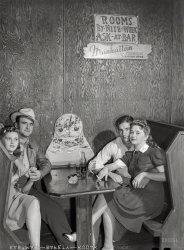
- The Herd: 1941
- ... Medium format acetate negative by John Vachon for the Farm Security Administration. View full size.
Chicago's El Trains ... Posted by Dave - 02/03/2020 - 2:39pm -
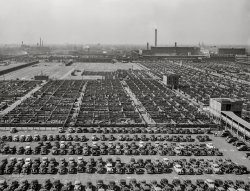
- Midland: 1941
- ... Pennsylvania." Acetate negative by Jack Delano for the Farm Security Administration. View full size.
What's that got to do with the ... Posted by Dave - 12/26/2018 - 1:18pm -
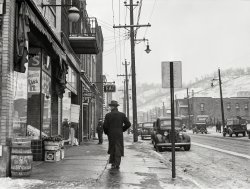
- Creative Differences: 1940
- ... Medium format acetate negative by Jack Delano for the Farm Security Administration. View full size.
Scriptorium The monks never ... Posted by Dave - 07/22/2021 - 5:00pm -
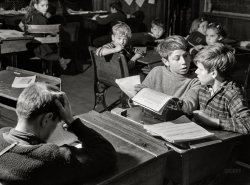
- Open All Night: 1940
- ... Medium format acetate negative by Jack Delano for the Farm Security Administration. View full size.
24 Hour Cafes Vancouver, ... Posted by Dave - 10/06/2021 - 11:00am -
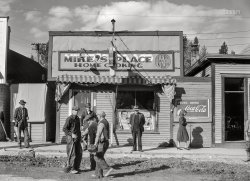
- Irrigon Oregon: 1939
- ... Morrow County, Oregon." Photo by Dorothea Lange for the Farm Security Administration. View full size.
Off-kilter The horizon is ... Posted by Dave - 04/18/2018 - 3:53pm -
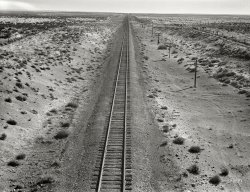
- Fargo Forum: 1940
- ... Dakota." 35mm nitrate negative by John Vachon for the Farm Security Administration. View full size.
I take offense! As someone ... Posted by Dave - 01/04/2012 - 8:19pm -
![Fargo Forum: 1940 October 1940. "Street corner in Fargo, North Dakota." 35mm nitrate negative by John Vachon for the Farm Security Administration. View full size.
I take offense!As someone with a "defective collecting gene" (I only have 3), I'll bet my hydrants can beat up your teaspoons or postcards. By the way, if you have one of these plugs just lying around the house let me know. 3 friends and I will come by and pick it up. They make great paperweights or bookmarks!
Spot-on, PerpsterAccording to the website of the Dickinson, North Dakota History Center, "As early as 1900, a process was discovered in Germany for extracting oil and water from raw coal and compacting the leftover char into large pellets [briquettes] for a more efficient fuel." Lehigh, North Dakota, was the home of the Lehigh Briquetting Company, which produced lignite coal briquettes. And, maybe they did "suit without soot." Here is a photo of the Lehigh plant from the collection of the State Historical Society of North Dakota.
Forum Fargonum MCMXXVIWell, it came to mind for no good reason. This was and is the city's newspaper building, the new one constructed in 1926, and still the home of the Forum Communications Company. Here is a wider shot.
Still thereUnder new management, and Google's Street View doesn't show us quite the same angle, but both the building and the plaque are still present:
View Larger Map
AnotherPiece of Photgraphic Art from John Vachon. What a wonderful shot; carefully composed and clean. A delight to the eye.
Lehigh BriquI'm guessing "Lehigh Briquettes - They Suit Witout Soot"
Danger....danger!I keep waiting for Dr Smith and young Will Robinson to appear.
On the lighter side, would you believe there are fire hydrant collectors out there? Years ago I stumbled over a website where you could post pictures of your hydrant collection.
Talk about the defective collecting gene!
[One man's trash is another man's... Well, you know.]
In Splunge's link, it almost looks like the same hydrant.
Defective collecting genesBeing a collector of just about everything (NOT a hoarder), I have managed to corner the market on bowling balls and bags, washboards and wooden shoes. Unfortunately I cannot find one other person on the planet who desires such things and my garage is at maximum capacity, so I have had to quit. I am grateful that I did not get into fire hydrant collecting and didn't even know there was any interest in it so we do learn something new every day on Shorpy.
Canine approvalThis photo has been recommended by the canine (doggie) members of my household as having historic value.
I see facesAnd I thought photographing inanimate objects with 'faces' this was a recent internet phenomenon.
(The Gallery, John Vachon)](https://www.shorpy.com/files/images/SHORPY_8a32528a.thumbnail.jpg)
- Parked Tight: 1940
- ... full size. 35mm nitrate negative by John Vachon for the Farm Security Administration.
ZOR The Mark of Zorro w/ Tyrone Power came out ... Posted by Dave - 01/03/2008 - 1:45am -
![Parked Tight: 1940 May 1940. Parked cars in Des Moines, Iowa. View full size. 35mm nitrate negative by John Vachon for the Farm Security Administration.
ZORThe Mark of Zorro w/ Tyrone Power came out in 1940, but it wasn't released until November.
Besides, I would expect a slashing Z rather than the boxy typeface they used here. And, of course, no apparent room for 'The Mark of'....
Isn't the Internet a wondrous thing?
And for all you film buffs out there, there is some extant gag footage (there's a phrase you don't hear every day) of Ty Power doing his trademark Z, but it's referred to on the soundtrack as 'gasp', the Mark of Zanuck!
but, I digress....
Reading MaterialIn the white car second from the left, looks like there's a newspaper in the back. Wonder what the headline was.
[ZOR - Dave]
ParkedI wonder how the driver got out of the cars after he parked them, or how is he planning to get in. Maybe they put first the car on the right, then the next one to his left and so on. Kind of a Tetris game!
SpaceIt looks like they still had about 1meter of space to open the door and go. But the way they were planning to get out of this parking must be interesting.
On the other hand it looks like a parking for office or small factory workers, so probably, as they ended work at the same hour, there was no problems with driving away.
[I think this was the view from John Vachon's hotel window. - Dave]
Running BoardsAll these cars have running boards, which means that although tightly packed, a driver could step on the adjoining car's running board as he got into his own car. It is odd that they would be parked so closely, though.
[These would have been parked by an attendant, not the owner. - Dave]
Bumper CarsA couple of these are brand-new cars. The second from the left in upper row with the one chevron-shaped taillight is a 1940 Ford standard coupe (the Deluxe had two taillights). Apparently in those days the bumper was there to bump. They must have backed the cars up 'till they heard or felt contact.
Parking lot?I read all the theories about the parking methods used in this "parking lot", but I think it more likely to be the parking lot of a car seller. That is the place where you, also nowadays, will find cars parked like "herrings in a barrel" (like is said in Dutch).
[You don't leave hats and packages in cars for sale. It's a typical urban pay lot, familiar to anyone who lives next to a vacant patch of land in a big-city American downtown. They still park them like this today. - Dave]
Washington D.C. parkingI worked in Washington during the early 70's and commuted to work in my personal car. The parking lot was behind the Old Post Office off of Pennsylvania Avenue. The attendants would start in the center and pack the other cars around it until the lot was filled. You can imagine what would happen if a person wanted to leave work early!
(The Gallery, Cars, Trucks, Buses, John Vachon)](https://www.shorpy.com/files/images/8a06256u.thumbnail.jpg)
- Snakebite: 1938
- ... Louisiana." 35mm nitrate negative by Russell Lee for the Farm Security Administration. View full size.
Really fast food And this ... Posted by Dave - 06/06/2012 - 1:16pm -
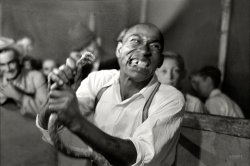
- Santa Fe Time: 1939
- ... Union. San Augustine, Texas." Photo by Russell Lee for the Farm Security Administration. View full size.
Extra keys under the ... Posted by Dave - 03/22/2018 - 10:57pm -
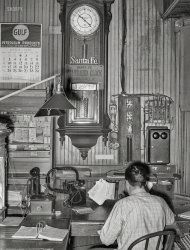
- Stella May: 1938
- ... Louisiana." 35mm negative by Russell Lee for the Farm Security Administration. View full size.
Madam Stella She looks ... Posted by Dave - 06/02/2008 - 11:44pm -
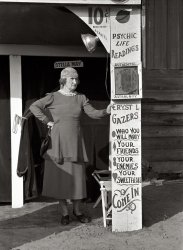
- Fishing Hole: 1941
- ... Medium format acetate negative by Russell Lee for the Farm Security Administration. View full size.
Certain Death? It would ... Posted by Dave - 07/12/2021 - 12:32pm -
![Fishing Hole: 1941 May 1941. Malheur County, Oregon. "Glory hole of the Owyhee Reservoir. Water for the Vale-Owyhee irrigation project is impounded here." Medium format acetate negative by Russell Lee for the Farm Security Administration. View full size.
Certain Death?It would seem like being sucked down that hole would be certain death. Why is there no safety fence around the hole that would prevent a person or animal that had been unfortunate enough to be pulled into its swirling vortex?
The only warning sign I can see is a 'No Fishing' sign - which obviously is being ignored.
[Not so. Read the rest of the sign. - Dave]
No gluts, no gloryIf there isn't enough water in the spring runoff, they aren't able to use the Glory Hole Spillway (err, Morning Glory Ring Gate). After some dry years, they had enough water to use the gate in 2017, and for several years after. Recently, they deliberately drew down water levels so they could do maintenance on the gate.
OK, Let's Be ClearI would not want to fall in there!
The hole? It's still there. But then, where else would it go?
A Descent into the MaelstromThat hole in the water brings to mind the 1845 story by Edgar Allan Poe. Who knows what’s inside this Owyhee Reservoir hole? Possibly not what the storyteller in Poe’s tale found: "Never shall I forget the sensations of awe, horror, and admiration with which I gazed about me. The boat appeared to be hanging, as if by magic, midway down, upon the interior surface of a funnel vast in circumference, prodigious in depth, and whose perfectly smooth sides might have been mistaken for ebony, but for the bewildering rapidity with which they spun around, and for the gleaming and ghastly radiance they shot forth, as the rays of the full moon, from that circular rift amid the clouds which I have already described, streamed in a flood of golden glory along the black walls, and far away down into the inmost recesses of the abyss.”
Glory holeI saw a picture of the gloryhole at flood stage and water was pouring down it at an alarming rate. The picture was captioned “Someone divided by zero.”
A decent descent"Glory hole" -- you don't want to know what information you get if you "google" it!
Look here for a decent description of the descent.
(The Gallery, Agriculture, Industry & Public Works, Kids, Russell Lee)](https://www.shorpy.com/files/images/SHORPY-8c01018a.thumbnail.jpg)
- Garden State: 1939
- ... Medium format negative by Arthur Rothstein for the Farm Security Administration. View full size.
Now? Not a rail buff, so ... Posted by Dave - 11/29/2017 - 12:17pm -
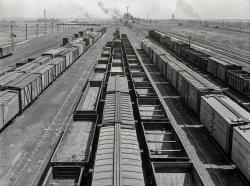
- Louisiana: 1937
- ... nitrate negative and caption by Dorothea Lange for the Farm Security Administration.
La. Woman I love her hat and parasol, with her ... Posted by Dave - 05/08/2013 - 11:12am -
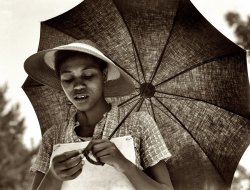
- A Busier Bisbee: 1940
- ... center." Medium format negative by Russell Lee for the Farm Security Administration. View full size.
Walgreen Agency Note the ... Posted by Dave - 10/23/2018 - 7:06pm -
![A Busier Bisbee: 1940 May 1940. "Main street of Bisbee, Arizona. Copper mining center." Medium format negative by Russell Lee for the Farm Security Administration. View full size.
Walgreen AgencyNote the Walgreen Agency drugstore.
"One of the most significant expansions during the 1930s was the establishment of an agency cooperative purchasing system, whereby Walgreen's products became available in a number of independent pharmacies. By 1934, there were 600 agencies in 33 US states, stocking over 1,000 Walgreen's products. At its peak the Walgreen's Agency system had more than 2,000 participants within the network. The system continued until 1980, when the administration of the cooperative purchasing program was discontinued."
On another note, Walgreen's invented the Malted Milkshake. I did not know that.
Copper Mining EconomicsIn the 1970's, I lived a few months in Ajo, Arizona. Phelps Dodge operated an open pit copper mine and smelter there. It was a company town. The price of copper spiked while I was there, and the workers were put on a 12 hour workday, seven days a week for four weeks, and then took a weekend off. On Monday, they started a new cycle of 12 on and 12 off. Most of the modest housing was built by Phelps Dodge and rented to the workers. After working for Phelps Dodge for five years, the workers could buy their house for $1.
National brands squeezing out the local guysThis is 1940 and I see Walgreen's, JC Penney, Woolworth's, Coca-Cola, Florsheim, Rexall, and maybe Blue Ribbon.
I hear so much about Chain Stores and national brands squeezing local stores as some modern problem, and here we are in the photograph. All we need is for that business at the end of the street to be a Sears. Many years ago Sears was accused of shutting down Main Street as Wal-Mart is today.
[That's the company store at the end of the street -- Phelps-Dodge Mercantile. - Dave]
Neon Signage lit up at nightI imagine it sure would've looked pretty. And attention grabbing.
The Review lives on. Looking from the other end of the street. More of the Bisbee Daily Review.
(The Gallery, Cars, Trucks, Buses, Russell Lee, Small Towns)](https://www.shorpy.com/files/images/SHORPY-8b24959a.thumbnail.jpg)
- Five & Dime: 1939
- ... Medium format negative by Dorothea Lange for the Farm Security Administration. View full size.
Car ID Chevrolet coupe with ... Posted by Dave - 08/22/2014 - 10:00am -
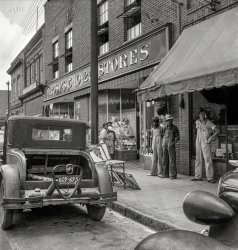
- Quiet City: 1940
- ... full size. 35mm nitrate negative by John Vachon for the Farm Security Administration.
Street Name? Anyone know what street this is in ... Posted by Dave - 07/18/2011 - 10:43am -
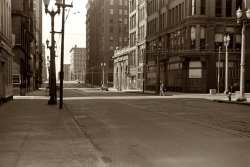
- Horse Clothing: 1940
- ... industry. 35mm nitrate negative by John Vachon for the Farm Security Administration. View full size.
Fly Net for the home I ... Posted by Dave - 09/03/2010 - 12:32am -
![Horse Clothing: 1940 July 1940. "Manitowoc, Wisconsin." Hub of the fly-net industry. 35mm nitrate negative by John Vachon for the Farm Security Administration. View full size.
Fly Net for the homeI used to have a Fly Net as a wall hanging back in the old hippie days. But then my wife wanted us to "class up" and got rid of it when I wasn't lookin'.
Women!
Timing A stroke of genius to wait for the kid on the wagon to come scooting along. Wonderful touch.
Wow, nice surpriseI was born and raised in Manitowoc. Population around 30,000. My whole family is still there. Yes, Manitowoc is known for their ice machines, cranes and Burger Boats. I'll have to find out where this building is. Many of the oldies still remain.
Horse CollarsI wonder if the Arrow Co. gave 'em much competition. Also, do you think they offered Wingtip Horseshoes?
Ice MachineManitowoc, Wisconsin is were Manitowoc ice machines are currently made. Our office got ours from them. There are still things made here in the USA.
[Indeed, the U.S. of A is still the largest producer of manufactured goods on Planet Earth. - Dave]
I Need a Raise Those basement windows tell a story of a once much lower street elevation before the paving. Apparently the effects of the automobile encroached on this business physically as well as economically.
Like a time machineI've only been to Manitowoc once, but part of it has the feel of America in the 1950s. Lots of old brick buildings, a fair amount of industry yet. Active shipyard, lots of steel bridges. And a coal fired ferry going across Lake Michigan from Manitowoc. This building seems typical of what is in that city today yet.
That wagonHow "Little Rascals" can you get? That's no Radio Flyer. I can only make what I believe says "Nash"? Someone with zoom powers help me here, please.
["Gamble's Flash." - Dave]
Looks like a Gamble's NashGamble's used to be a chain of department stores or hardware stores, can't remember which. I do remember going to them with my Grandparents when I was young though.
[You remember correctly. And the wagon says "Gamble's Flash." - Dave]
Horse pantsSome previous Shorpy examples of horse clothes and fly nettiing.
(The Gallery, Horses, John Vachon, Kids)](https://www.shorpy.com/files/images/8a06502a.thumbnail.jpg)
- Curb Service: 1940
- ... California." Medium format negative by Russell Lee for the Farm Security Administration. View full size.
Here, smoke my brand My ... Posted by Dave - 08/28/2018 - 11:03am -
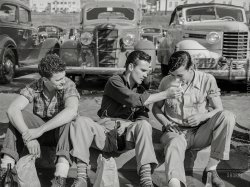
- Route 99: 1939
- ... 4x5 inch nitrate negative by Dorothea Lange for the Farm Security Administration. View full size.
Long way to Anywhere In the ... Posted by Dave - 06/12/2021 - 12:34pm -
![Route 99: 1939 April 1939. "U.S. 99 on ridge over Tehachapi Mountains. Heavy truck route between Los Angeles and San Joaquin Valley over which migrants travel back and forth." 4x5 inch nitrate negative by Dorothea Lange for the Farm Security Administration. View full size.
Long way to AnywhereIn the '30s, Dad drove a tractor near Fresno. Mom had to move back to Burbank to run her beauty shop -- too poor to stay together. Two hundred miles in a Model T coupe or in Grandpa's old Buick were the only means of travel between. I have the love letters they wrote. Years later and on trips much faster, we called 99 "the looooonnnngggg stretch."
PotentialWhat that stretch needs is a WaWa, McDonalds, Starbucks, and maybe a Taco Bell to make it more civilized and up to date.
Hairy RoadWe lived in Tehachapi for three years, 1984 to 1986, and that road is positively exciting at times when you go down to Bakersfield. I was pregnant in 1986 and had to go to the hospital in Bakersfield to deliver. The small local hospital in town didn't do deliveries unless you were having the baby on their doorstep, and the fire station halfway down was very practiced at deliveries! The other direction into Mojave was a much easier slope at least. The worst problem was staying out of the way of big trucks going down to Bakersfield, their brakes often overheated and they had to pull off to let them cool down. I learned very quickly to not get in their blind spots. Foggy conditions, or snow the occasional ice/snow could make it extra exciting.
Pre I-5Before there were interstate highways, this was transportation a la mode. Twice I traveled cross country (SF to Mississippi) before the Interstates. It was part of the vacation, spending four or six days hopping from motel to motel, packing and unpacking the Buick, meeting exotic girls from St Louis or Cleveland in the motel; pools,. and loading up the swamp cooler with ice twice a day... and yes, we did go this route!
Then it all changed. I always wished we'd taken the train! I-40 and I-10 were simply different.
Looks Like the 5 I’m pretty sure this is the 5 now, atop the grapevine between Bakersfield and Los Angeles.
Nope, not that oneIt's a great photograph. I can appreciate in that location Dorthea Dorothea Lange heard only the sounds she made and possibly the sound of the car. I wonder how many vehicles had passed and how long she had to wait before she got the photograph she wanted?
[Six. - Dave]
Woody's WordsThis photo by the incredible Dorothea Lange makes me think of Woody Guthrie's song lyrics to his fellow Okies who were trying to find a better life in California:
Lots of folks back East, they say, is leavin' home every day
Beatin' the hot old dusty way to the California line
'Cross the desert sands they roll, gettin' out of that old dust bowl
They think they're goin' to a sugar bowl but here's what they find
Now the police at the port of entry say
"You're number fourteen thousand for today"
Oh, if you ain't got the do re mi folks, if you ain't got the do re mi
Why you better go back to beautiful Texas
Oklahoma, Kansas, Georgia, Tennessee
California is a garden of Eden, a paradise to live in or see
But believe it or not you won't find it so hot
If you ain't got the do re mi
Lonely RoadI hope that driver doesn't need to stop for directions.
(The Gallery, Agriculture, Cars, Trucks, Buses, Dorothea Lange, Landscapes)](https://www.shorpy.com/files/images/SHORPY-8b33420a1.thumbnail.jpg)
- Drugstore Noir: 1940
- ... in Santa Fe, New Mexico." Photo by Russell Lee for the Farm Security Administration. View full size.
Manhole cover I think the ... Posted by Dave - 01/04/2014 - 6:09pm -
![Drugstore Noir: 1940 July 1940. "Street scene at the fiesta in Santa Fe, New Mexico." Photo by Russell Lee for the Farm Security Administration. View full size.
Manhole coverI think the manhole cover in the 1940 Shorpy photo is the same manhole cover of on the southeast corner of the Santa Fe Plaza shown in the Google Maps street view link below:
http://bit.ly/JUMJEu
Yes, Santa Fe - Stowe's Drug StoreFrom the Wednesday, September 5, 1934, Santa Fe New Mexican. Stowe's Drug Store, located on the SW corner of the Plaza.
Santa Fe?I lived for many years in Santa Fe, New Mexico and I doubt VERY HIGHLY that there has ever been that type of archetecture in that city.
[Yes, Santa Fe. And the word is "architecture." - Dave]
Just making comment according to my experience from having lived in Santa Fe. I see little need in you making "nasty" about my spelling, Dave... Getting a bit burned out, are we?
[VERY HIGHLY. -Dave]
I don't care! It isn't Santa Fe. You said on Facebook that it probably isn't Taos, but Santa Fe. That means you don't really know, now do you?
[Scroll up. -Dave]
No questionThe building in the picture no longer exists as it burned in 1946 and was eventually replaced by the building that now houses Ortega's. The new building retains the 'bevel' in the corner seen here. One clincher is to go to street view and see the manhole cover in the same place.
cf. Hammett, 'Santa Fe, A walk through time'. This reference contains a photo showing the identical brickwork above the entrance, as well as the information given above.
Just SayingNow that we've settled on Santa Fe as the location. Am I wrong or is this photo not in focus?
[Motion blur from camera and subject movement due to slow shutter speed. -tterrace]
Santa Fe has changed a few timesThe adobe-covered Santa Fe we know today is mostly a deliberate 20th-century creation inspired by a citizens' movement in the 1910s or so. If you peruse photos from a hundred years ago, you'll see Santa Fe looked like any other Western town of the era with buildings like this drugstore on every corner. We would consider the styles quaint today, but at the time they were derided as cookie-cutter architecture that could have come from anywhere and didn't honor New Mexico's history. Laws were actually passed around then requiring new and renovated buildings to adopt a pueblo-like adobe (usually stucco in reality) facade. In fact, pretty much any adobe-style building in central Santa Fe that was built before the 1920s now looks nothing like its original appearance.
I've seen older buildings under renovation near the Plaza, and it's always jarring when the stucco comes down to reveal briefly a Victorian brick facade underneath!
It's the Claire Hotel buildingYes, this is Santa Fe, New Mexico. If you want to see a good shot of the building as it was, here's a link to our online catalog.
The previous poster is correct; the building burned in 1946, and the replacement building is much smaller and less notable than the historic one.
(The Gallery, Russell Lee, Stores & Markets)](https://www.shorpy.com/files/images/SHORPY_8d23989u.thumbnail.jpg)
- Pony Mart: 1939
- ... Medium format negative by Arthur Rothstein for the Farm Security Administration. View full size.
Cheap gas As an automobile ... Posted by Dave - 12/08/2017 - 11:19am -
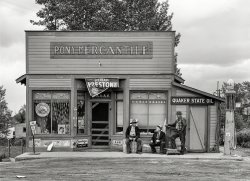
- Cattleman's Bar: 1938
- ... South Omaha, Nebraska." Photo by John Vachon for the Farm Security Administration. View full size.
Cobbs Creek Click to ... Posted by Dave - 08/02/2017 - 9:22am -
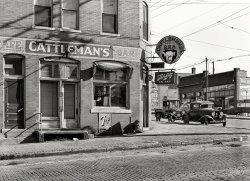
- Pittsburgh Panorama: 1941
- ... Medium format acetate negative by John Vachon for the Farm Security Administration. View full size.
Look out below! To that guy ... Posted by Dave - 06/11/2020 - 10:21am -
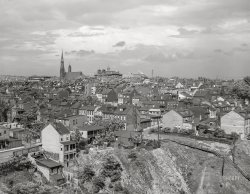
- On the Mend: 1941
- ... Virginia." Acetate negative by John Vachon for the Farm Security Administration. View full size.
That's some bad hat, ... Posted by Dave - 02/17/2021 - 1:17pm -
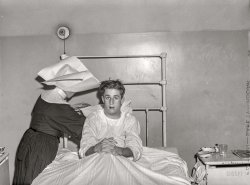
- Dakota Depot: 1940
- ... glimpsed here . Acetate negative by John Vachon for the Farm Security Administration. View full size.
Hopper Come a Cropper This ... Posted by Dave - 01/17/2022 - 6:15pm -
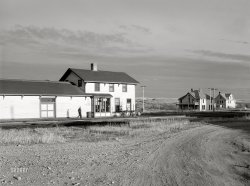
- Behind the Scenes: 1938
- ... of his home." View full size. Medium-format negative, Farm Security Administration.
Who'll Hold the Camera? And the next photo ... Posted by Dave - 09/11/2011 - 10:38am -
![Behind the Scenes: 1938 September 1938. Westover, West Virginia. Marion Post Wolcott and her intrepid camera head downstairs: "Miner takes shower, which he built in the cellar of his home." View full size. Medium-format negative, Farm Security Administration.
Who'll Hold the Camera?And the next photo shows Marion wedged under his chassis.
Bargain BasementAre you sure this is not Montana? I see Butte.
At least we are not seeing junk this time.
Seriously, why put a shower downstairs? This has to be one of the oddest pictures you have unearthed yet.
[Probably because there's no bathroom upstairs. - Dave]
Basement ShowerMany miners, farmers and others who get very dirty at work have showers in the basement so that they don't spread the coal dust/dirt through the house.
Basement ShowerMy grandfather built a shower in the basement of his family's farmhouse in New Martinsville, WV back in the 40's. Until the late fifties that was the only bathroom plumbing in the house. A two-tub sink and a full mirror, along with a medicine cabinet and shelf for towels stand beside it. It's still where we're instructed to go when we get dirty working 365 acres of land. This picture is every bit of familiar to me.
Mining PhotosOne of the most extensive collections of Mining Photography and mining artifacts is located within the West Virginia State Archives and State Museum Collection at the Cultural Center in Charleston. I have compared the faces of miners in the hand-loading era with those of sailors in the sail era. They are strikingly similar. I guess the stress and strain of an extremely dangerous, and physically demanding job took its toll all who were there.
[Was there something memorable about this face in particular? - Dave]
(The Gallery, M.P. Wolcott, Mining)](https://www.shorpy.com/files/images/8c29836u.thumbnail.jpg)
- Iron Man: 1941
- ... Medium format safety negative by John Vachon for the Farm Security Administration. View full size.
Grand Canyon of the North ... Posted by Dave - 05/17/2014 - 11:40pm -
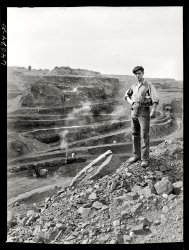
- Domestic Bliss: 1936
- ... six people in Missouri. May 1936. View full size. Farm Security Administration photograph by Carl Mydans.
Domestic Bliss, 1936 ... Posted by Dave - 09/07/2011 - 7:47pm -
